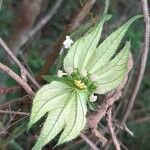Leaves up to 13 × 14 cm, 3-fid or 3-lobed, rarely 5-lobed, shallowly to deeply cordate at the base with 5–9 basal nerves; lobes 3–10 × 1.5–4 cm, subequal, obovate to elliptic-oblanceolate or lanceolate, acutely acuminate to obtuse at the apex, serrate to subentire, slightly or not constricted at the base, puberulous or pubescent along the nerves, sometimes with scattered urticating hairs, or else subglabrous; lateral nerves in 5–9 pairs; stipels 1–3 mm long.
Inflorescences axillary; peduncles 1–10 cm long, leafless or with a small leaf near the base; bract stipules 1.5–5 mm long, lanceolate; bracts (1)2–4 × (1)2.5–4 cm, ovate in outline, 3-lobed, often shallowly so, the lobes triangular-lanceolate, acute or subacute, glandular-serrate to subentire, cordate at the base, 7–9-nerved from the base, glabrous or pubescent without and within, cream-coloured to pale green.
Female flowers: pedicels 2 mm long, extending to 1.5 cm in fruit; sepals 6–9, sepal rhachis 2.5 mm long, extending to 0.8–1.5 cm in fruit, linear, lateral lobules in 6–10 pairs, gland-tipped, pubescent and with urticating hairs; ovary c. 1 mm in diameter, densely pubescent; stylar column 5–7 mm long, abruptly dilated and excavated at the apex.
Female bracts 2–3(4), ovate or oblong; the adaxial bract 2 mm long, repand-denticulate; the abaxial bracts 3 mm long, ± entire; the lateral bracts smaller, undulate, all ciliate.
Male peduncles 3–5 mm long, involucre 5–8 mm across, 13-flowered; mass of fused bracts and aborted flowers adaxial, flattened.
Male flowers: pedicels 3 mm long; calyx lobes 5, 2 mm long, elliptic-ovate, subglabrous; stamens 20–30, rarely fewer.
A slender pubescent and often urticating trailing or climbing perennial herb; stems up to 3 m from a woody stock.
Seeds 3–3.5 × 3–3.5 mm, ± smooth, pale grey or dark reddish-brown and streaked and mottled with silvery-grey.
Fruit 5 × 8–10 mm, ± smooth, pubescent, brownish.
Stipules 2–7 mm long, linear-lanceolate.
Petioles 1–9 cm long.


